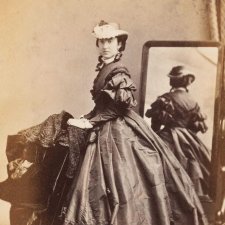- About us
- Support the Gallery
- Venue hire
- Publications
- Research library
- Organisation chart
- Employment
- Contact us
- Make a booking
- Onsite programs
- Online programs
- School visit information
- Learning resources
- Little Darlings
- Professional learning
The 1850s and 1860s witnessed considerable expansion and consolidation of the Catholic Church’s activities in Australia, the population growth occasioned by the gold rush – and the threats to morality and religiosity which were perceived to have attended it – throwing the need for priests and churches into greater relief. Faiths such as Methodism had been more readily established, as they didn’t require consecrated buildings or people for their observances. Catholicism, however, had been hampered in the early colonial period by scarcity of personnel, religious intolerance and other factors. In 1832, one Catholic priest wrote of New South Wales that ‘there are 16,000 or 18,000 Catholics in this colony, not one half of whom hardly ever see a priest.’ Sydney received its first Catholic archbishop in 1842 when The Most Reverend Dr John Bede Polding OSB (1794–1877) – the centrepiece of this work – was appointed to the role, having for the previous several years served as ‘vicar-apostolic of New Holland, Van Diemen’s Land and the adjoining islands.’ It was Polding’s task to build the colony’s Catholic infrastructure, creating churches and schools, facilitating the establishment of local branches of religious orders, and attracting priests and nuns. In due course he had Adelaide, Hobart and Melbourne made sees, and in 1847 James Alipius Goold (1812–1886) – at left in the centre row – was installed as the first Catholic Archbishop of Melbourne. Like Polding, Goold oversaw the recruitment of clergy and the building of schools and churches – most notably the construction of St. Patrick’s Cathedral. His visits to the goldfields in late 1854 and 1855 are said to have contributed to the orderly behaviour of Catholic miners in the wake of the Eureka rebellion.
The printmaker Henry Sadd, who worked in Australia from 1853 until his death 40 years later, was known for creating mezzotints based on photographs. This work is a photograph of a mezzotint that was itself made from individual photographs of the sitters. In the top row, left to right, are: The Most Reverend Dr James Murray (1828–1909), Lord Bishop of Maitland from 1865 to 1909; The Most Reverend Dr William Lanigan (1820–1900), Lord Bishop of Goulburn from 1867 to 1900; and The Most Reverend Dr Mathew Quinn (d. 1885), Lord Bishop of Bathurst from 1866 to 1885. In the middle row, left to right, are: Goold, Polding and The Right Reverend Dr Lawrence Bonaventure Sheil OSF (1815–1872), Lord Bishop of Adelaide from 1866 to 1872. In the bottom row, left and right are: The Right Reverend Daniel Murphy (1815–1907), Lord Bishop of Hobart Town from 1866 to 1881; and The Most Reverend Dr James Quinn (1819–1881), Lord Bishop of Brisbane from 1859 to 1881.
Collection: National Portrait Gallery
Purchased 2010
Archibald McDonald (age 38 in 1869)
Henry Samuel Sadd (age 58 in 1869)
James Murray (age 41 in 1869)
William Lanigan (age 49 in 1869)
James Alipius Goold (age 57 in 1869)
Lawrence Bonaventure Sheil OSF (age 54 in 1869)
Daniel Murphy (age 54 in 1869)
James Quinn (age 50 in 1869)



On one level The Companion talks about the most famous and frontline Australians, but on another it tells us about ourselves.



Drawn from the NPG’s burgeoning collection of cartes de visite, Carte-o-mania! celebrates the wit, style and substance of the pocket-sized portraits that were taken and collected like crazy in post-goldrush Australia.



Visit us, learn with us, support us or work with us! Here’s a range of information about planning your visit, our history and more!